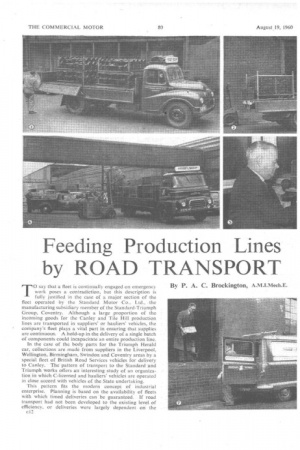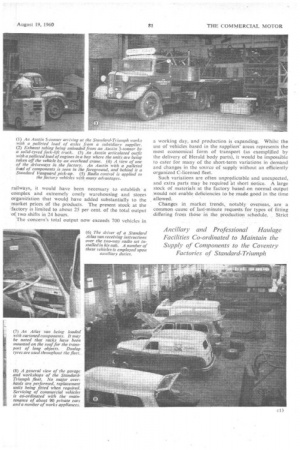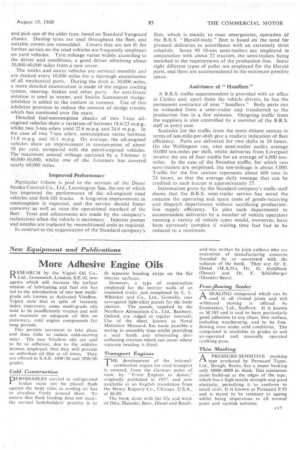Feeding Production Lines
Page 48

Page 49

Page 50

Page 51

If you've noticed an error in this article please click here to report it so we can fix it.
by ROAD TRANSPORT By P. A. C. Brockington, A.M.I.Mech.E. TO saythat a fleet is continually engaged on emergency work poses a contradiction, but this description is fully justified in the case of a major section of the fleet operated by the Standard Motor Co., Ltd., • the manufacturing subsidiary member of the Standard-Triumph Group, Coventry. Although a large proportion of the incoming goods for the -Canley and Tile Hill production lines are transported in suppliers' or hauliers' vehicles, the company's fleet plays a viral part in ensuring that supplies are continuous. A.hold-up in the delivery of.a single batch of components could incapacitate an entire production line. In the case of the body parts for the Triumph Herald car, collections are. made from suppliers in the Liverpool, Wellington, Birmingham, Swindon and Coventry areas by a special fleet of British Road Services vehicles for delivery to Canley. The pattern of transport to the Standard and Triumph works offers an interesting study of an organization'in which C-licensed and hauliers vehicles are operated in close accord with vehicles of the State undertaking.
This pattern fits the modern concept of industrial enterprise. Planning is based on the availability of fleets With which timed deliveries can be guaranteed. If road transport had not been developed to the existing level of efficiency, or deliveries were largely dependent on the c1`) railways, it would have been necessary to establish a complex and extremely costly warehousing and stores organization that would have added substantially to the market prices of the products. The present stock at the factory is limited to about 25 per cent. of the total output of two shifts in 24 hours.
The concern's total output now exceeds 700 vehicles in a working day, and production is expanding. Whilst the use of vehicles based in the suppliers' areas represents the most economical form of transport (as exemplified by the delivery of Herald body parts), it would be impossible to cater for many of the short-term variations in demand and changes in the source of supply without an efficiently organized C-licensed Such variations are often unpredictable and unexpected, and extra parts may be required 'at short notice. A large stock of materials at the factory based on normal output would not enable deficiencies to be made good in the time allowed.
Changes in market trends, notably overseas, are a common cause of last-minute requests for types of fitting differing from those in the production schedule. Strict inspection of all incoming components inevitably produces a number of rejects over a period, and if the rejects in a single batch exceed the average by a wide margin, breakdown of the production line can be avoided only by emergency action.
Catering for emergencies is greatly facilitated by the use of Pye two-way. radio installations, sets being fitted to 10 vehicles of the works fleet and to three vans based at company's depots. Messages are relayed through the G.P.O. aerial at Meriden, and the average maximum radius is 30-35 miles.
About 80 per cent. of the • work of the fleet comprises collections from suppliers and from factories of the group in the Birmingham and Black Country areas, which are covered by this radius, and vehicle drivers can keep in constant touch with the traffic manager.
In a typical emergency, the components required would represent a part-load which could easily be accommodated in a vehicle which left the works for the suppliers' area before the need was known. Re-routeing the vehicle by radio contact obviates the necessity of sending a stand-by vehicle to the suppliers, and the extra parts can be collected with the minimum of delay. A driver was recently recalled to the works after he had travelled some 50 miles on his way to a centre on a round trip of 300 miles. Advice had been received that the supply source had been changed, and radio contact provided an operational saving of two vehicle-days.
Radio control thus enables the size of the fleet to be substantially reduced and affords advantages that could not be provided by a much larger fleet. For example, a driver can immediately contact a senior member of the office staff for advice or a snap decision, or to give details of an unusual type of delay or development requiring investigation.
Of the 37 rigid vehicles and prime movers in the company's fleet, all are of Austin manufacture, apart from a Karrier Bantam 2-ton drop-sided platform vehicle powered by a 2.3-litre oil engine, which is based at the Slough depot, This is used for a ferry service between Slough and a depot in, Western Avenue. An additional Bantam is on order. This will have a 13-ft. 6-in, platform in place of the standard 12-ft. type.
Rigids and " Artics "
The main Austin works fleet comprises two forwardcontrol 7-ton rigids with 5.1-litre oil engines, two normal-control 5-ton lorries equipped with similar units, two forward-control 3-ton rigid oilers powered by 3.4-litre engines, and nine petrol-engined tractors for use in conjunc tion with 8-ton semi-trailers. A 2-tonner, seven 5-ton lorries and four 5-ton tippers make up the remainder of the works vehicles, all of which are powered by petrol engines.
Operated in close collaboration with the works fleet, the eight vehicles of the spares department include an 8-ton articulated and three 10-ton outfits and four 5-ton lorries, the larger tractors being oilers with 5.1-litre engines. A total of 18 semi-trailers is employed, comprising 10 Eagle 8-ton vehicles with 23-ft. bodies and eight Carrimores. Five of the units are 10-tormers with 26-ft. bodies whilst eight are older-type 8-tonners.
c14 Apart from a number of retractor-type couplings fitted to some of the Carrimore vehicles, all the semi-trailers are equipped with S.A.E. fifth-wheel couplings. The claim that retractor couplings reduce jack-knifing tendencies is considered valid by some of the drivers.
The bodies of both rigid vehicles and semi-trailers are of the drop-sided platform type and are modified in detail to enable the fork-lift truck to operate close to the vehicle (occasional impact with the sides of the platform is then inevitable) without a high incidence of damage to the bodywork.
Pallet loading is mainly used for inter-factory movements and for handling about half of the parts transported from suppliers' premises. A higher percentage is, however, unloaded by fork truck, a substantial proportion of the goods being bundles of tube, bar, and so on, which can be lifted by forks without the aid of pallets.
Body _modifications include the fitting of 21-in, steel shrouds over the wooden chock rails and wooden buffer strips along the sides. These protect the chock rails, drop sides and hinge pins, and steel tie bars arranged transversely under the platform increase resistance to. damage. The wooden floor planks are also mounted transversely to provide easy replacement in the event of local damage.
Other modifications and non-standard fittings include rubber wings at the rear of all vehicles, rubber mounting of rear lights and reflectors, snap rings on the securing pegs of the drop sides, and painted white strips on the sides of the semi-trailers. All vehicles are finished in the Standard dark blue livery, transfers being used for the StandardTriumph name flashes.
Replaced After Eight Years
On average, the yearly mileage is 12,000-15,000, and vehicles are replaced after eight years, representing about 100,000 miles. No major overhauls are performed on the premises, replacement units being fitted as required. The oil engines receive a top overhaul at mileage intervals of about 40,000, whilst the frequency in the case of petrol engines is about 20,000. Servicing and overhauls are co-ordinated with the maintenance of about 90 private cars and a large number of fork-lift trucks and mobile machines employed in the works, making a total of approximately 350 vehicles.
An auxiliary fleet of 50-60 smaller vehicles comprises Atlas 10-12-cwt. vans and nick-ups, 6-cwt. vans based on the company's 10-h.p. chassis and a number of 12-cwt. vans
and pick-ups of the older type, based on Standard Vanguard chassis. Dunlop tyres are used throughout the fleet, and suitable covers are remoulded. Covers that are not fit for further service on the road vehicles are frequently employed on yard vehicles. Tyre mileage varies widely according to the driver and conditions, a good driver obtaining about, 30,000-40,000 miles from a new cover.
The works and stores vehicles are serviced monthly and are docked every 10,000 miles for a thorough examination of all mechanical parts. During the dock at 30,000 miles, a more detailed examination is made of the engine cooling system, steering, brakes and other parts. An anti-freeze solution is used in winter, and Smiths Summereol sludgeinhibitor is added to the coolant in summer. Use of this inhibitor promises to reduce the amount of sludge trouble which has continued over the years.
Detailed fuel-consumption checks of two 5-ton oilengined vehicles show a variation of between 18.6-23 mpg., whilst two 3-ton oilers yield 22.6 m.p.g. and 24.6 m.p.g. In the case of two 7-ton oilers, consumption varies between 13.8 m.p.g. and 16.1 m.p.g. On average, the oil-engined vehicles show an improvement in consumption of about 50 per cent, compared with the petrol-engined vehicles. The maximum annual mileage operated by a 5-tonner is 40,000-50,000, whilst one of the 3-tonners has covered nearly 60,000 miles.
Improved Performance Particular tribute is paid to the services of the Diesel Smoke Control Co., Ltd., Leamington Spa, the use of which has improved the performance of the oil-engined road vehicles and fork-lift trucks. A long-term improvement in consumption is expected, and the service should foster economy as well as raise the operational standard of the fleet. Tests and adjustments are made by the company's technicians when the vehicle is stationary. Injector pumps and nozzles are replaced by reconditioned units as required.
In contrast to the organization of the Standard company's
fleet, which is mainly to meet emergencies, operation of the B.R.S. " Herald-body " fleet is based on the need for planned deliveries in accordance with an extremely strict schedule. Some 90 10-ton semi-trailers are employed in conjunction with about 22 tractors, the semi-trailers being matched to the requirements of the production line. Some eight different types of pallet are employed for the Herald parts, and these are accommodated in the minimum possible space.
Assistance of " Handlers " A B.R.S. traffic superintendent is provided with an office at Cranky and, apart from the vehicle drivers, he has the permanent assistance of nine "handlers." Body parts can be unloaded from a semi-trailer and transferred to the production line in a few minutes. Outgoing traffic from the suppliers is also controlled by a member of the B.R.S. staff in every case.
Statistics for the traffic from the more distant centres in terms of ton-mile-per-shift give a realistic indication of fleet efficiency. Parts are delivered for two shifts in 24 hours. On the Wellington run, nine semi-trailer outfits average 10,000 ton-miles per shift, whilst deliveries from Liverpool involve the use of four outfits for an average of 6,000 tonmiles. In the case of the Swindon traffic, for which two semi-trailers are employed, the ton-mileage is about 3,000. Traffic for the five centres represents about 600 tons in 24 hours, so that the average daily tonnage that can be credited to each tractor is approximately 27.
Information given by the Standard company's traffic staff shows that the B.R.S. semi-trailer service has saved the concern the operating and space costs of goods-receiving and dispatch departments without sacrificing productionline supply efficiency. To plan such departments to accommodate deliveries by a number of vehicle operators running_a variety of vehicle types would, moreover, have been extremely complex if waiting time had had to be reduced to a minimum.
































































































